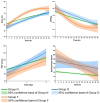Distinct profiles of cerebral oxygenation in focal vs. secondarily generalized EEG seizures in children undergoing cardiac surgery
- PMID: 38784902
- PMCID: PMC11111896
- DOI: 10.3389/fneur.2024.1353366
Distinct profiles of cerebral oxygenation in focal vs. secondarily generalized EEG seizures in children undergoing cardiac surgery
Abstract
Objectives: Seizures are common in children undergoing cardiopulmonary bypass (CPB). Cerebral oxygen saturation (ScO2) by near-infrared spectroscopy is routinely monitored in many centers, but the relations between the levels and changes of ScO2 and brain injuries remain incompletely understood. We aimed to analyze the postoperative profiles of ScO2 and cerebral blood flow velocity in different types of EEG seizures in relation to brain injuries on MRI.
Methods: We monitored continuous EEG and ScO2 in 337 children during the first 48 h after CPB, which were analyzed in 3 h periods. Cerebral blood flow peak systolic velocity (PSV) in the middle cerebral artery was measured daily by transcranial Doppler. Postoperative cerebral MRI was performed before hospital discharge.
Results: Based on the occurrence and spreading types of seizures, patients were divided into three groups as patients without seizures (Group N; n = 309), those with focal seizures (Group F; n = 13), or with secondarily generalized seizures (Group G; n = 15). There were no significant differences in the onset time and duration of seizures and incidence of status epilepticus between the two seizures groups (Ps ≥ 0.27). ScO2 increased significantly faster across Group N, Group G, and Group F during the 48 h (p < 0.0001) but its overall levels were not significantly different among the three groups (p = 0.30). PSV was significantly lower (p = 0.003) but increased significantly faster (p = 0.0003) across Group N, Group G, and Group F. Group F had the most severe brain injuries and the highest incidence of white matter injuries on MRI among the three groups (Ps ≤ 0.002).
Conclusion: Postoperative cerebral oxygenation showed distinct profiles in secondarily generalized and particularly focal types of EEG seizures in children after CPB. A state of 'overshooting' ScO2 with persistently low PSV was more frequently seen in those with focal seizures and more severe brain injury. Information from this study may have important clinical implications in detecting brain injuries when monitoring cerebral oxygenation in this vulnerable group of children after CPB.
Keywords: brain injuries; cardiopulmonary bypass; cerebral oxygen saturation; focal seizures; secondarily generalized seizures.
Copyright © 2024 Lin, Du, Ning, Zhang, Feng, Chen, Ma and Li.
Conflict of interest statement
The authors declare that the research was conducted in the absence of any commercial or financial relationships that could be construed as a potential conflict of interest.
Figures



Similar articles
-
Cerebral oxygenation during pediatric cardiac surgery using deep hypothermic circulatory arrest.Anesthesiology. 1995 Jan;82(1):74-82. doi: 10.1097/00000542-199501000-00011. Anesthesiology. 1995. PMID: 7832338
-
The Relationships of Cerebral and Somatic Oxygen Saturation with Physiological Parameters in Pediatric Cardiac Surgery with Cardiopulmonary Bypass: Analysis Using the Random-Effects Model.Pediatr Cardiol. 2021 Feb;42(2):370-378. doi: 10.1007/s00246-020-02492-y. Epub 2020 Nov 17. Pediatr Cardiol. 2021. PMID: 33201327
-
Electroencephalographic seizures after neonatal cardiac surgery with high-flow cardiopulmonary bypass.Anesth Analg. 2010 Jun 1;110(6):1680-5. doi: 10.1213/ANE.0b013e3181dd5a58. Epub 2010 Apr 30. Anesth Analg. 2010. PMID: 20435942
-
Comparison of pH-stat and alpha-stat cardiopulmonary bypass on cerebral oxygenation and blood flow in relation to hypothermic circulatory arrest in piglets.Anesthesiology. 1998 Jul;89(1):110-8. doi: 10.1097/00000542-199807000-00018. Anesthesiology. 1998. PMID: 9667301
-
Age Difference of the Relationship Between Cerebral Oxygen Saturation and Physiological Parameters in Pediatric Cardiac Surgery with Cardiopulmonary Bypass: Analysis Using the Random-Effects Model.Pediatr Cardiol. 2022 Oct;43(7):1606-1614. doi: 10.1007/s00246-022-02889-x. Epub 2022 Jun 3. Pediatr Cardiol. 2022. PMID: 35657421
References
-
- Gaynor JW, Jarvik GP, Gerdes M, Kim DS, Rajagopalan R, Bernbaum J, et al. . Postoperative electroencephalographic seizures are associated with deficits in executive function and social behaviors at 4 years of age following cardiac surgery in infancy. J Thorac Cardiovasc Surg. (2013) 146:132–9. doi: 10.1016/j.jtcvs.2013.04.002, PMID: - DOI - PMC - PubMed
-
- Naim MY, Gaynor JW, Chen J, Nicolson SC, Fuller S, Spray TL, et al. . Subclinical seizures identified by postoperative electroencephalographic monitoring are common after neonatal cardiac surgery. J Thorac Cardiovasc Surg. (2015) 150:169–80. doi: 10.1016/j.jtcvs.2015.03.045, PMID: - DOI - PMC - PubMed
LinkOut - more resources
Full Text Sources

